Effect of the Matrix Melt Flow Index and Fillers on Mechanical Properties of Polypropylene-Based Composites
Abstract
1. Introduction
2. Materials and Methods
2.1. Materials
2.2. Processing of Composites
2.3. Characterization of Composites
2.3.1. Microstructure
2.3.2. Tensile Test
2.3.3. Flexural Test
2.3.4. Impact Test
2.3.5. Hardness Test
3. Results and Discussion
3.1. Microstructures
3.2. Tensile Test
3.3. Flexural Test
3.4. Impact Test
3.5. Hardness Test
4. Conclusions
Author Contributions
Funding
Institutional Review Board Statement
Informed Consent Statement
Data Availability Statement
Acknowledgments
Conflicts of Interest
References
- Composites Market Size, Share & Trends Analysis Report by Product (Carbon, Glass), by Resin (Thermosetting, Thermoplastics), by Manufacturing Process, by End Use, and Segment Forecasts, 2020–2027; Grand View Research, Inc.: San Francisco, CA, USA, 2020; p. 142.
- Polypropylene Compounds Market Size, Share & Trends Analysis Report By Product (Mineral Filled, Compounded TPO, Compounded TPV, Glass Reinforced), By End Use, And Segment Forecasts, 2019–2025; Grand View Research, Inc.: San Francisco, CA, USA, 2019; p. 120.
- Xanthos, M. Functional Fillers for Plastics, 2nd ed.; Wiley-VCH: Hoboken, NJ, USA, 2010. [Google Scholar]
- Seymour, R.B. The Role of Fillers and Reinforcements in Plastics Technology. Polym. -Plast. Technol. Eng. 1976, 7, 49–79. [Google Scholar] [CrossRef]
- Rezaei, F.; Yunus, R.; Ibrahim, N.; Mahdi, E. Effect of fiber loading and fiber length on mechanical and thermal properties of short carbon fiber reinforced polypropylene composite. Malays. J. Anal. Sci. 2007, 11, 181–188. [Google Scholar]
- Junaedi, H.; Albahkali, E.; Baig, M.; Dawood, A.; Almajid, A. Ductile to Brittle Transition of Short Carbon Fiber-Reinforced Polypropylene Composites. Adv. Polym. Technol. 2020, 2020, 6714097. [Google Scholar] [CrossRef]
- Ghanbari, A.; Jalali, A.; Nofar, M.; Mamun, A.; Arjmand, M. Extrinsic toughening of recycled carbon fibers in polypropylene composites in the absence of plasticity penalty. J. Compos. Mater. 2022, 56, 941–950. [Google Scholar] [CrossRef]
- Kalaitzidou, K.; Fukushima, H.; Drzal, L.T. Mechanical properties and morphological characterization of exfoliated graphite–Polypropylene nanocomposites. Compos. Part A Appl. Sci. Manuf. 2007, 38, 1675–1682. [Google Scholar] [CrossRef]
- Al-Saleh, M.A.; Yussuf, A.A.; Al-Enezi, S.; Kazemi, R.; Wahit, M.U.; Al-Shammari, T.; Al-Banna, A. Polypropylene/Graphene Nanocomposites: Effects of GNP Loading and Compatibilizers on the Mechanical and Thermal Properties. Materials 2019, 12, 3924. [Google Scholar] [CrossRef]
- Ajorloo, M.; Fasihi, M.; Khoramishad, H. The role of nanofiller size and polymer chain configuration on the properties of polypropylene/graphite nanoplates composites. J. Taiwan Inst. Chem. Eng. 2020, 108, 82–91. [Google Scholar] [CrossRef]
- Lai, M.-F.; Huang, C.-H.; Lin, J.-H.; Chuang, Y.-C.; Wang, C.-H.; Lou, C.-W. Polypropylene/Carbon Fiber Composite Layered Materials: Electromagnetic Interference Shielding Effect and Mechanical Performance. Fibers Polym. 2021, 22, 2552–2562. [Google Scholar] [CrossRef]
- Zhang, H.; Zhang, Z.; Park, H.-W.; Zhu, X. Influence of surface-modified TiO2 nanoparticles on fracture behavior of injection molded polypropylene. Front. Mater. Sci. China 2008, 2, 9–15. [Google Scholar] [CrossRef]
- Aydemir, D.; Uzun, G.; Gumuş, H.; Yildiz, S.; Gumuş, S.; Bardak, T.; Gunduz, G. Nanocomposites of Polypropylene/Nano Titanium Dioxide: Effect of Loading Rates of Nano Titanium Dioxide. Mater. Sci. 2016, 22, 364–369. [Google Scholar] [CrossRef]
- Vidakis, N.; Petousis, M.; Velidakis, E.; Tzounis, L.; Mountakis, N.; Kechagias, J.; Grammatikos, S. Optimization of the Filler Concentration on Fused Filament Fabrication 3D Printed Polypropylene with Titanium Dioxide Nanocomposites. Materials 2021, 14, 3076. [Google Scholar] [CrossRef]
- Bendaoued, A.; Messaoud, M.; Harzallah, O.; Bistac, S.; Salhi, R. Nano-TiO2 effect on thermal, rheological and structural properties of thermoplastic polypropylene nanocomposites. J. Mater. Res. Technol. 2022, 17, 2313–2325. [Google Scholar] [CrossRef]
- Xuan, L.; Han, G.; Wang, D.; Cheng, W.; Gao, X.; Chen, F.; Li, Q. Effect of Surface-Modified TiO2 Nanoparticles on the Anti-Ultraviolet Aging Performance of Foamed Wheat Straw Fiber/Polypropylene Composites. Materials 2017, 10, 456. [Google Scholar] [CrossRef]
- Zhang, C.; Zhong, L.; Wang, D.; Zhang, F.; Zhang, G. Anti-ultraviolet and anti-static modification of polyethylene terephthalate fabrics with graphene nanoplatelets by a high-temperature and high-pressure inlaying method. Text. Res. J. 2018, 89, 1488–1499. [Google Scholar] [CrossRef]
- Pereira, P.; Ferreira, D.P.; Araújo, J.C.; Ferreira, A.; Fangueiro, R. The Potential of Graphene Nanoplatelets in the Development of Smart and Multifunctional Ecocomposites. Polymers 2020, 12, 2189. [Google Scholar] [CrossRef]
- Cabello-Alvarado, C.; Reyes-Rodríguez, P.; Andrade-Guel, M.; Cadenas-Pliego, G.; Pérez-Alvarez, M.; Cruz-Delgado, V.J.; Melo-López, L.; Quiñones-Jurado, Z.V.; Ávila-Orta, C.A. Melt-Mixed Thermoplastic Nanocomposite Containing Carbon Nanotubes and Titanium Dioxide for Flame Retardancy Applications. Polymers 2019, 11, 1204. [Google Scholar] [CrossRef]
- Netkueakul, W.; Fischer, B.; Walder, C.; Nüesch, F.; Rees, M.; Jovic, M.; Gaan, S.; Jacob, P.; Wang, J. Effects of Combining Graphene Nanoplatelet and Phosphorous Flame Retardant as Additives on Mechanical Properties and Flame Retardancy of Epoxy Nanocomposite. Polymers 2020, 12, 2349. [Google Scholar] [CrossRef]
- Moradkhani, G.; Fasihi, M.; Brison, L.; Laoutid, F.; Vahabi, H.; Saeb, M.R. Flame retardancy effect of phosphorus graphite nanoplatelets on ethylene-vinyl acetate copolymer: Physical blending versus chemical modification. Polym. Adv. Technol. 2021, 32, 4296–4305. [Google Scholar] [CrossRef]
- Carvalho, G.B.; Canevarolo, S.V.; Sousa, J.A. Influence of interfacial interactions on the mechanical behavior of hybrid composites of polypropylene/short glass fibers/hollow glass beads. Polym. Test. 2020, 85, 106418. [Google Scholar] [CrossRef]
- Sarabi, M.T.; Behravesh, A.H.; Shahi, P.; Daryabari, Y. Effect of polymeric matrix melt flow index in reprocessing extruded wood–plastic composites. J. Thermoplast. Compos. Mater. 2014, 27, 881–894. [Google Scholar] [CrossRef]
- Bremner, T.; Rudin, A.; Cook, D.G. Melt flow index values and molecular weight distributions of commercial thermoplastics. J. Appl. Polym. Sci. 1990, 41, 1617–1627. [Google Scholar] [CrossRef]
- Balasuriya, P.W.; Ye, L.; Mai, Y.W. Mechanical properties of wood flake–polyethylene composites. Part I: Effects of processing methods and matrix melt flow behaviour. Compos. Part A Appl. Sci. Manuf. 2001, 32, 619–629. [Google Scholar] [CrossRef]
- Sharma, M.; Bijwe, J. Influence of molecular weight on performance properties of polyethersulphone and its composites with carbon fabric. Wear 2012, 274–275, 388–394. [Google Scholar] [CrossRef]
- ASTM D638-14; Standard Test Method for Tensile Properties of Plastics. ASTM International: West Conshohocken, PA, USA, 2014.
- ASTM D790-10; Standard Test Methods for Flexural Properties of Unreinforced and Reinforced Plastics and Electrical Insulating Materials. ASTM International: West Conshohocken, PA, USA, 2010.
- ASTM D256-10; Standard Test Methods for Determining the Izod Pendulum Impact Resistance of Plastics. ASTM International: West Conshohocken, PA, USA, 2010.
- ASTM D2240-15; Standard Test Method for Rubber Property—Durometer Hardness. ASTM International: West Conshohocken, PA, USA, 2015.
- Zitzenbacher, G.; Dirnberger, H.; Längauer, M.; Holzer, C. Calculation of the Contact Angle of Polymer Melts on Tool Surfaces from Viscosity Parameters. Polymers 2018, 10, 38. [Google Scholar] [CrossRef]
- Chen, P.; Lu, C.; Yu, Q.; Gao, Y.; Li, J.; Li, X. Influence of fiber wettability on the interfacial adhesion of continuous fiber-reinforced PPESK composite. J. Appl. Polym. Sci. 2006, 102, 2544–2551. [Google Scholar] [CrossRef]
- Ashraf, M.A.; Peng, W.; Zare, Y.; Rhee, K.Y. Effects of Size and Aggregation/Agglomeration of Nanoparticles on the Interfacial/Interphase Properties and Tensile Strength of Polymer Nanocomposites. Nanoscale Res. Lett. 2018, 13, 214. [Google Scholar] [CrossRef]
- Kim, S.-J.; Moon, J.-B.; Kim, G.-H.; Ha, C.-S. Mechanical properties of polypropylene/natural fiber composites: Comparison of wood fiber and cotton fiber. Polym. Test. 2008, 27, 801–806. [Google Scholar] [CrossRef]
- Hemanth, R.; Sekar, M.; Suresha, B. Effects of Fibers and Fillers on Mechanical Properties of Thermoplastic Composites. Indian J. Adv. Chem. Sci. 2014, 2, 28–35. [Google Scholar]
- Junaedi, H.; AlMajid, A.A.; Friedrich, K. Mechanical Properties and Microstructures of Exfoliated Graphite Nano Platelet Reinforced Thermoplastic Nanocomposites. In Proceedings of the 9th International Conference on Composite Science and Technology, Sorrento, Italy, 24–26 April 2013. [Google Scholar]
- Kinloch, A.J.; Williams, J.G. Crack blunting mechanisms in polymers. J. Mater. Sci. 1980, 15, 987–996. [Google Scholar] [CrossRef]
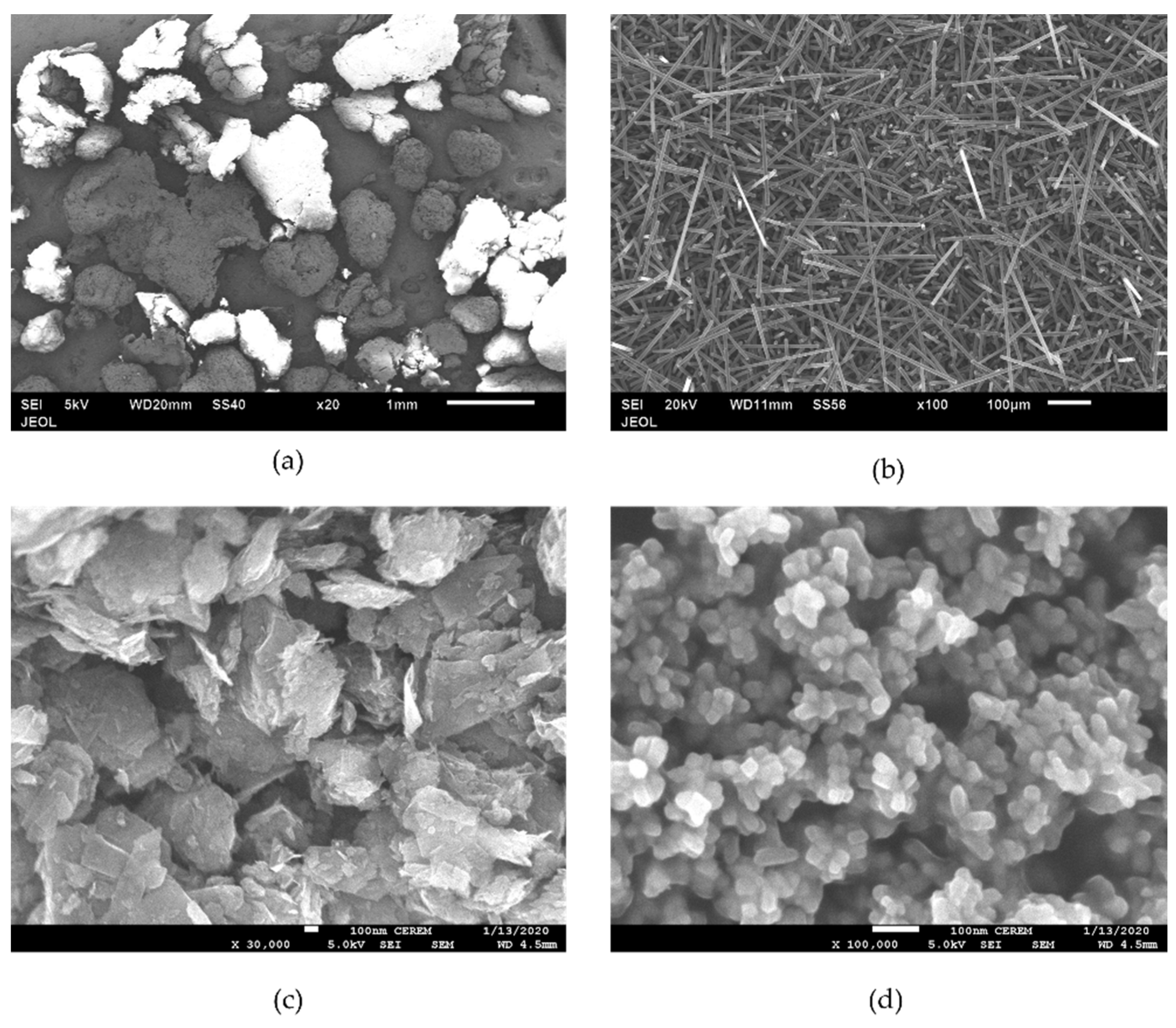

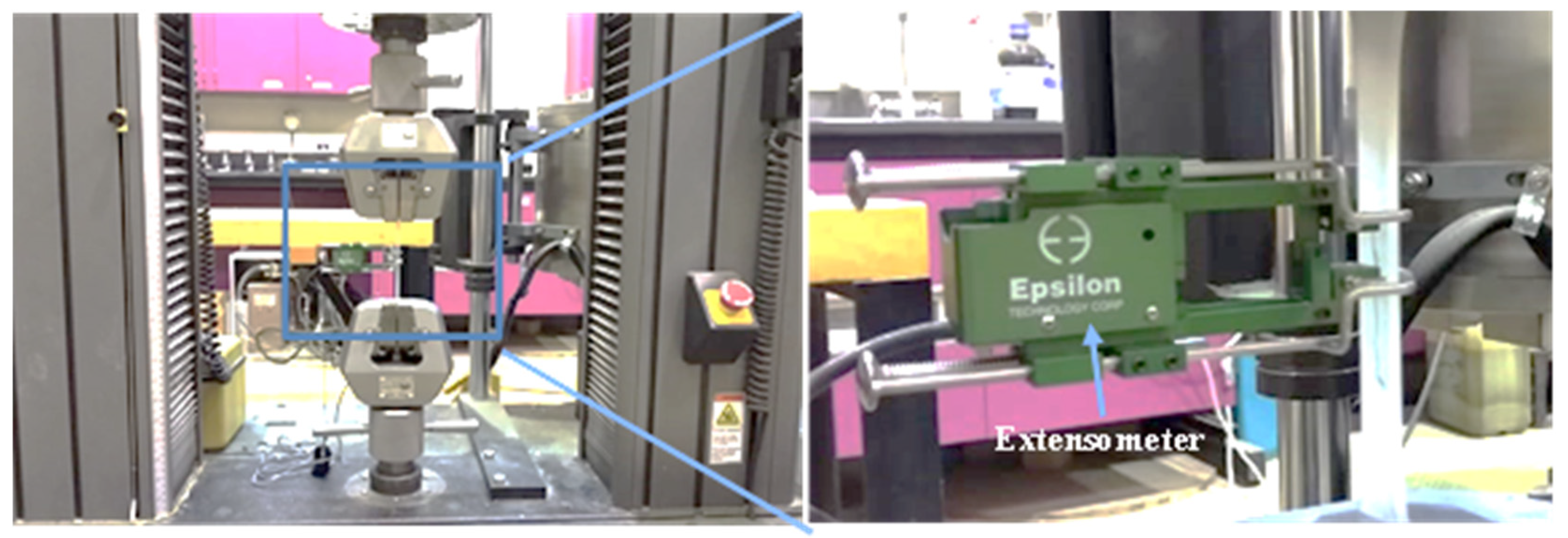
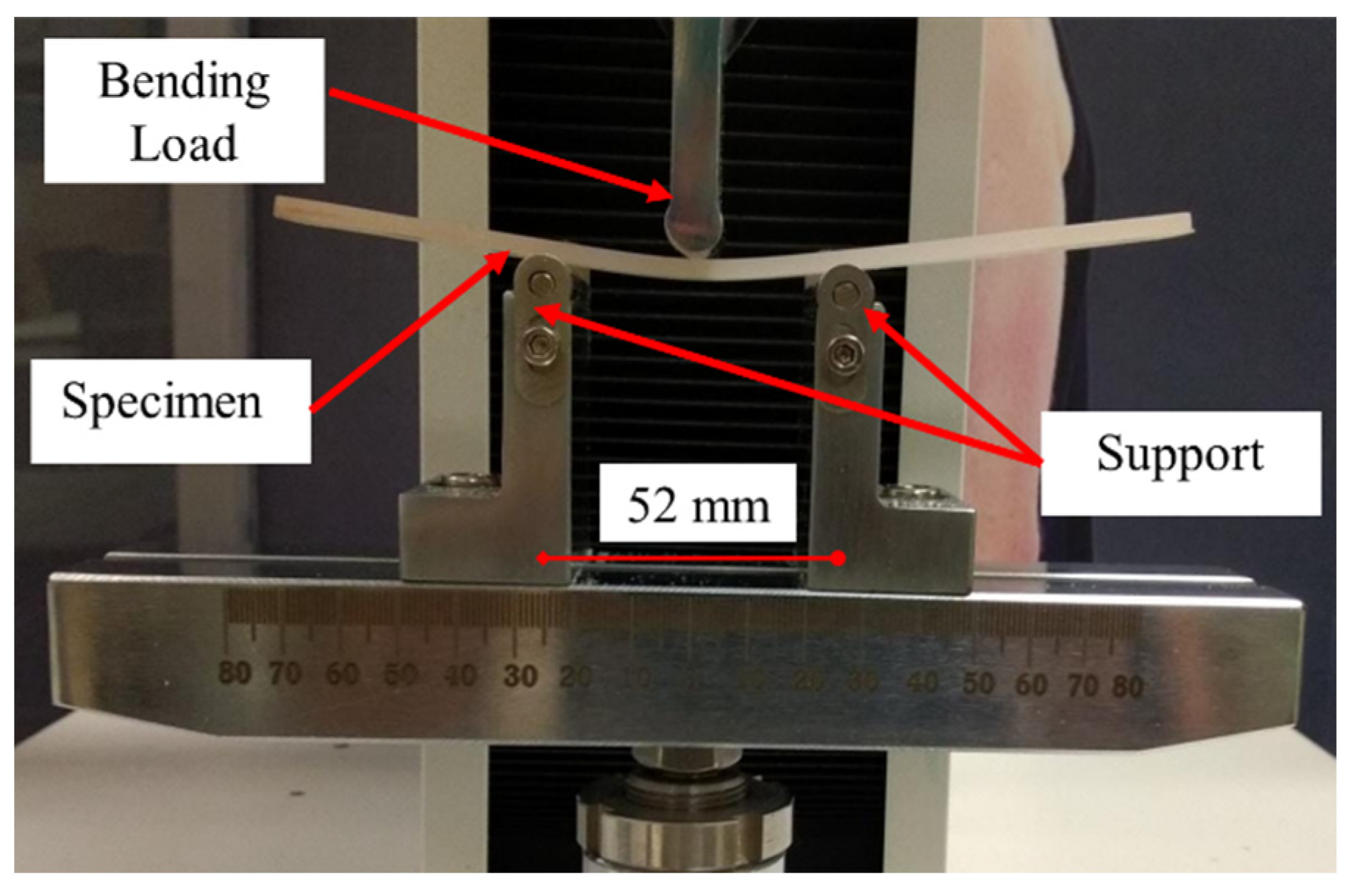
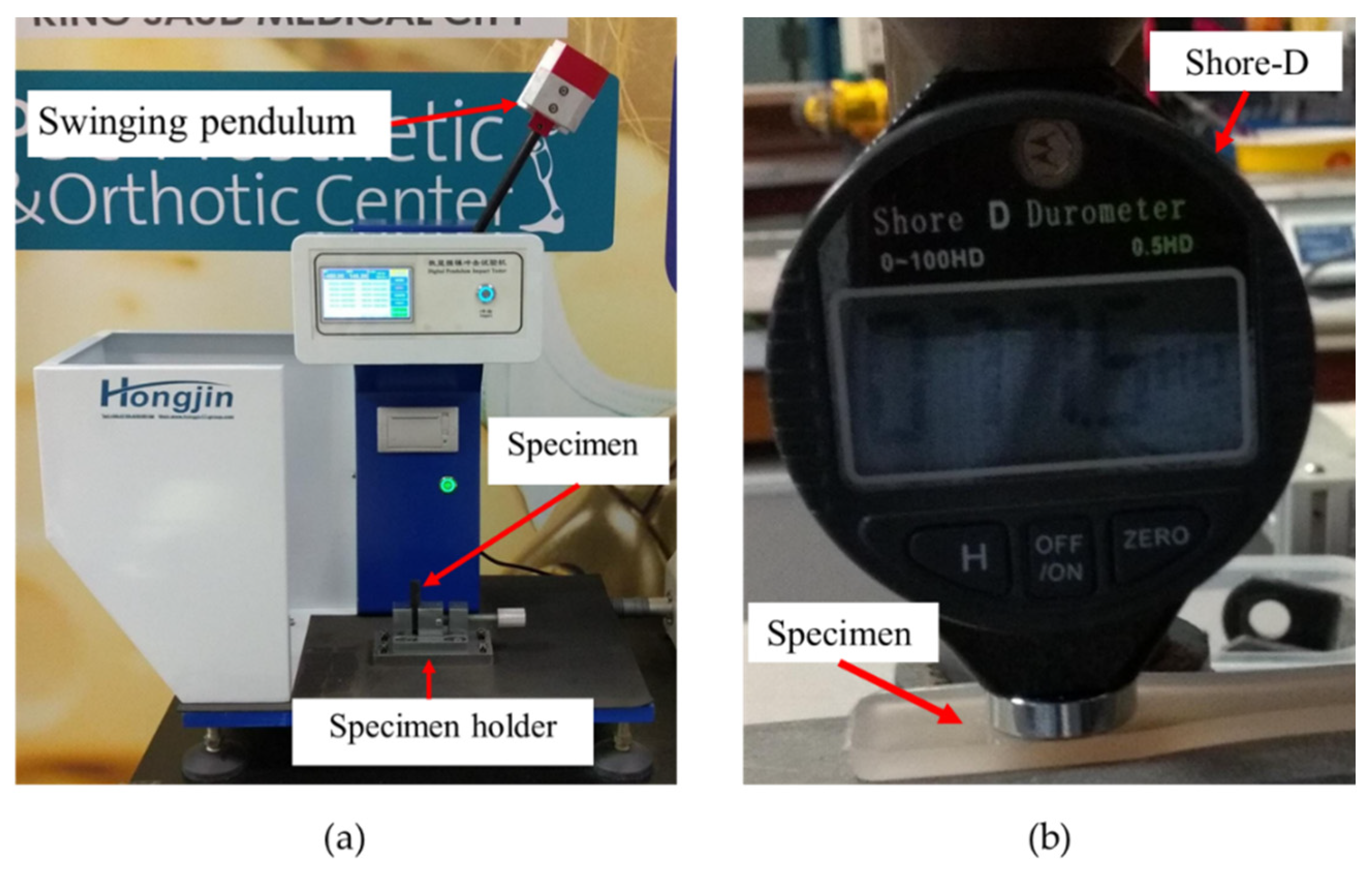
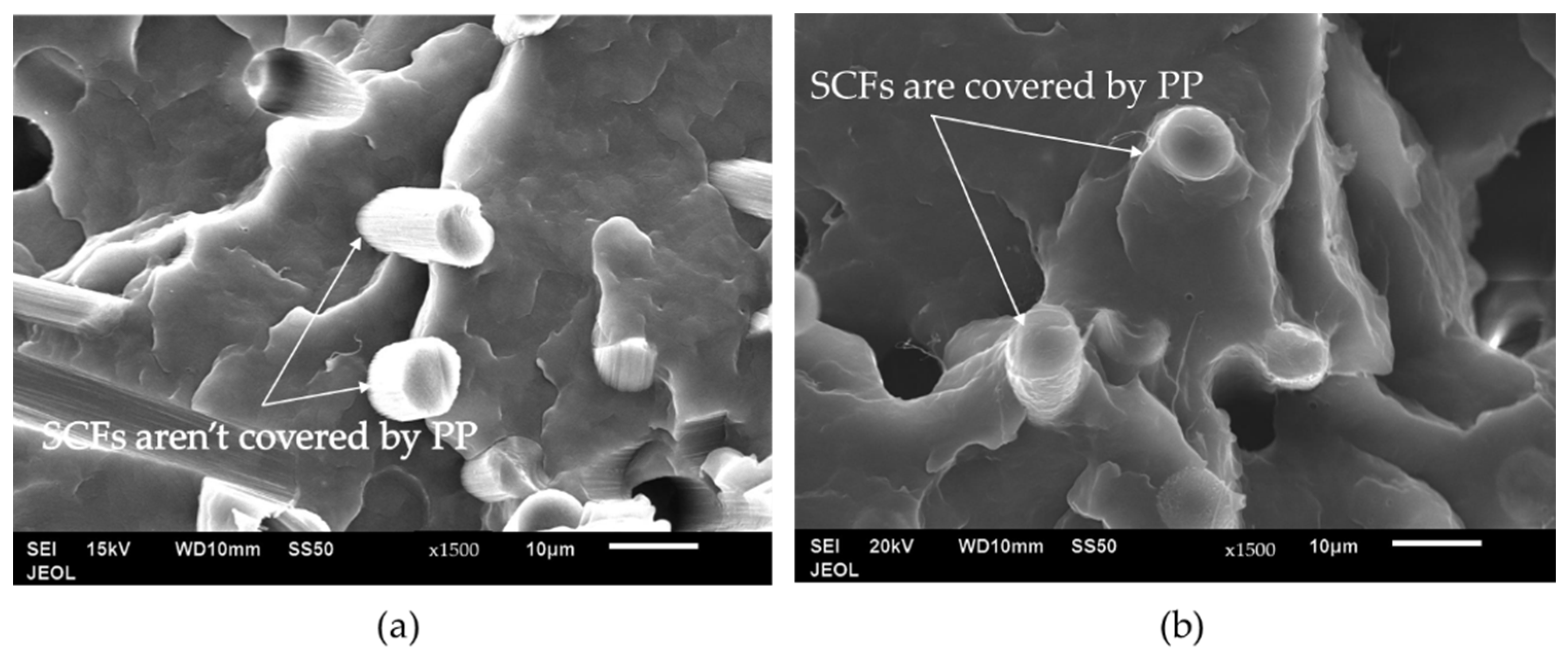
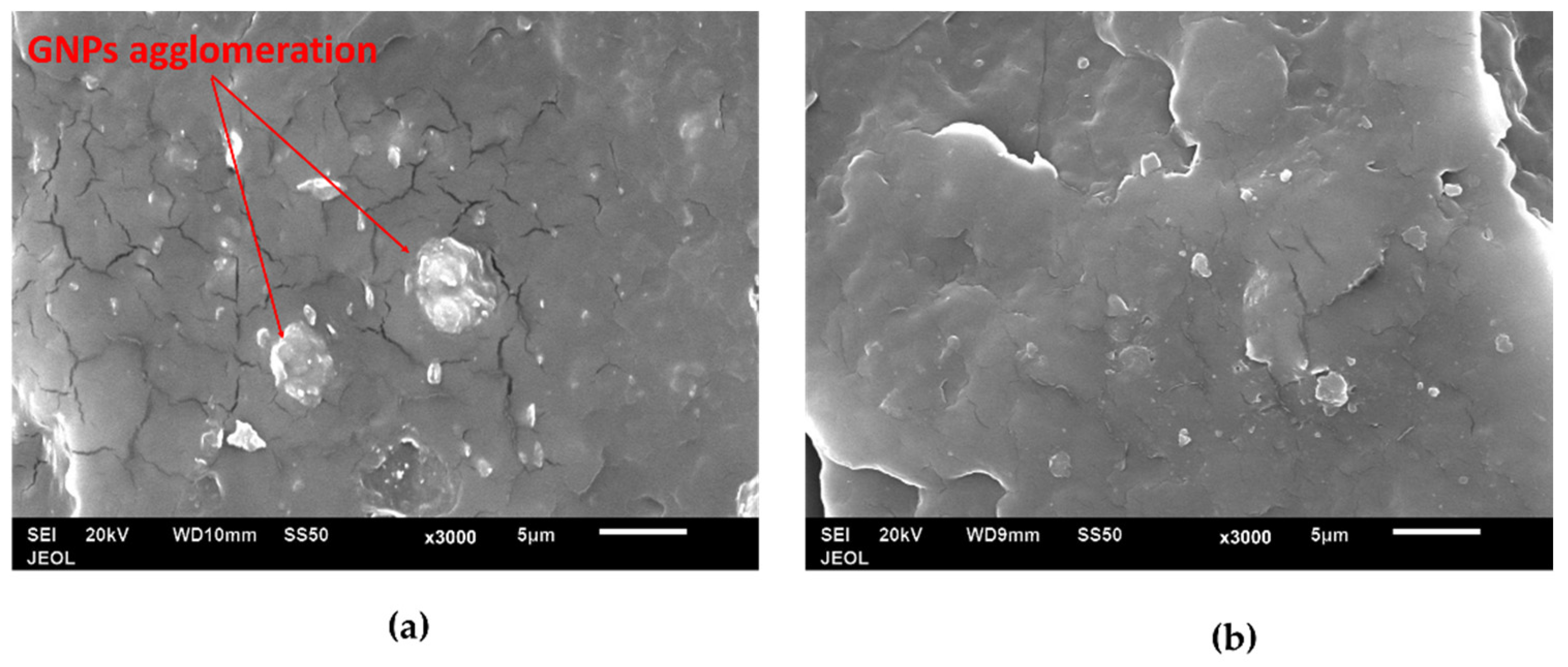

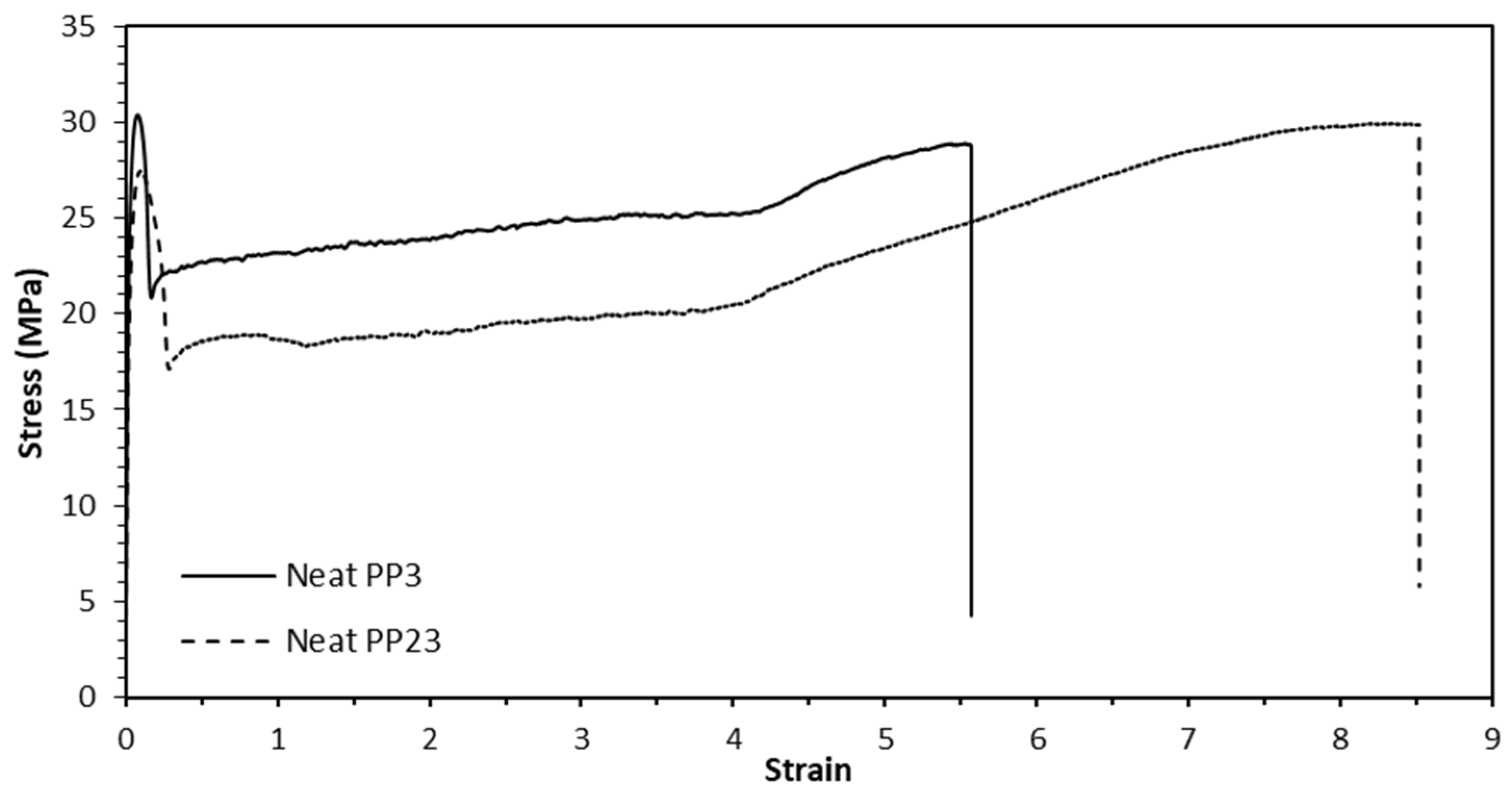
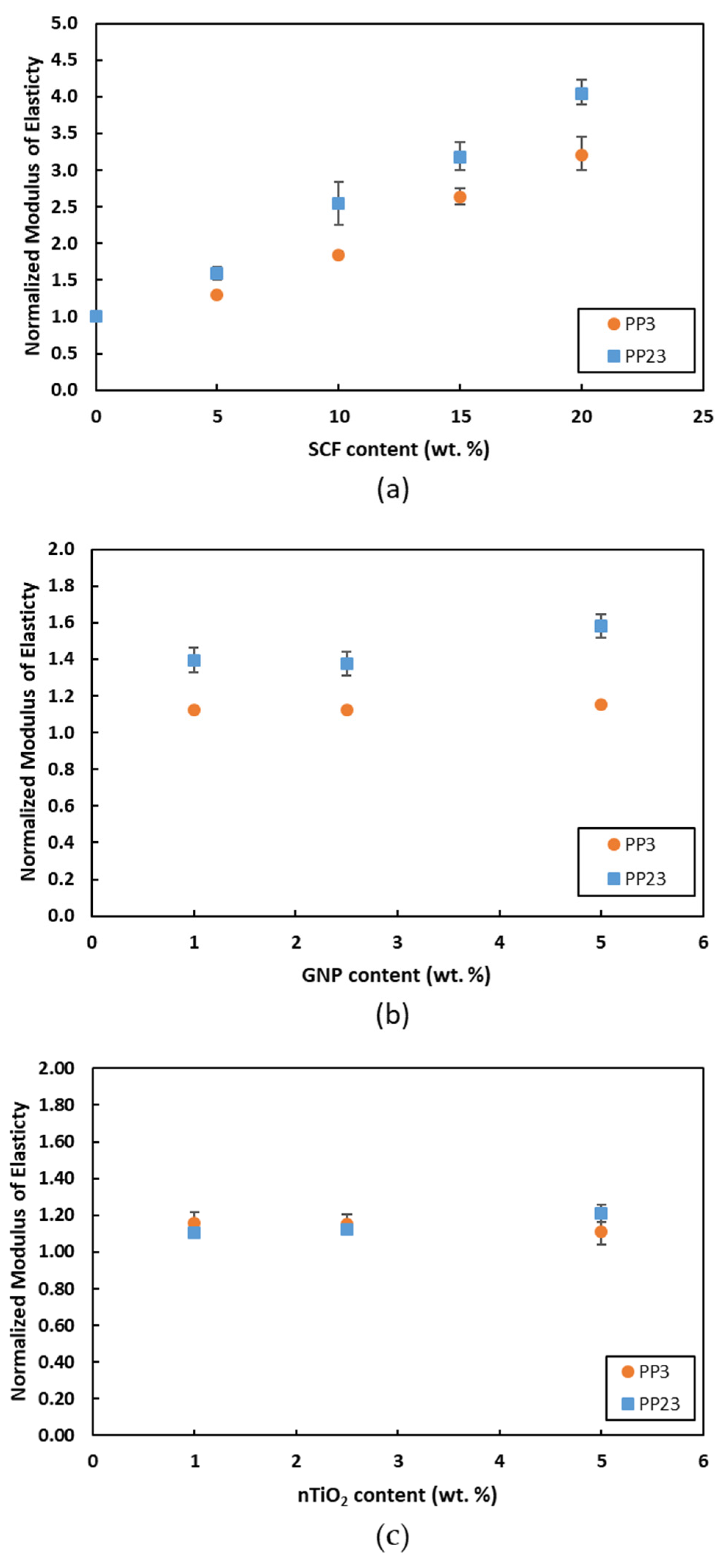


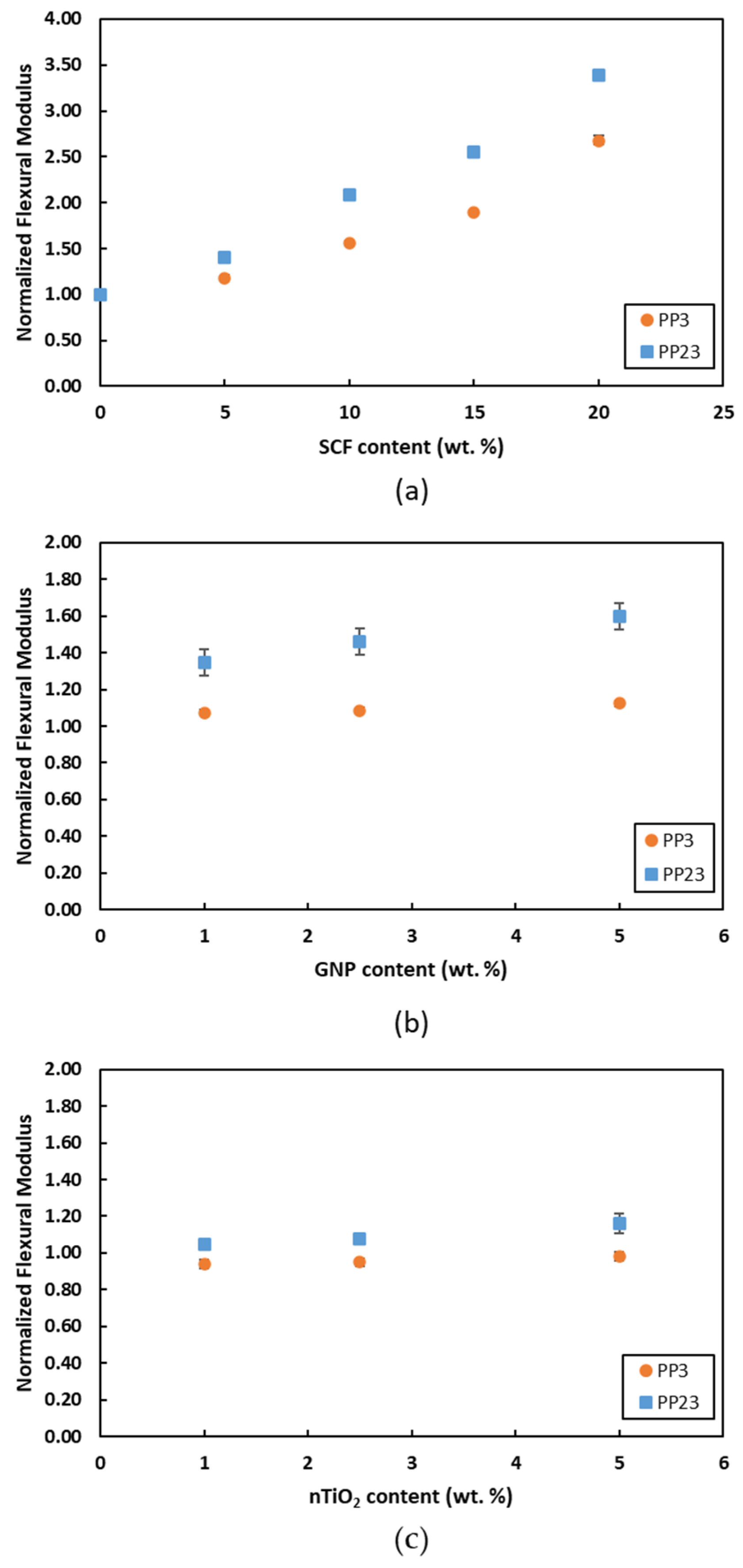
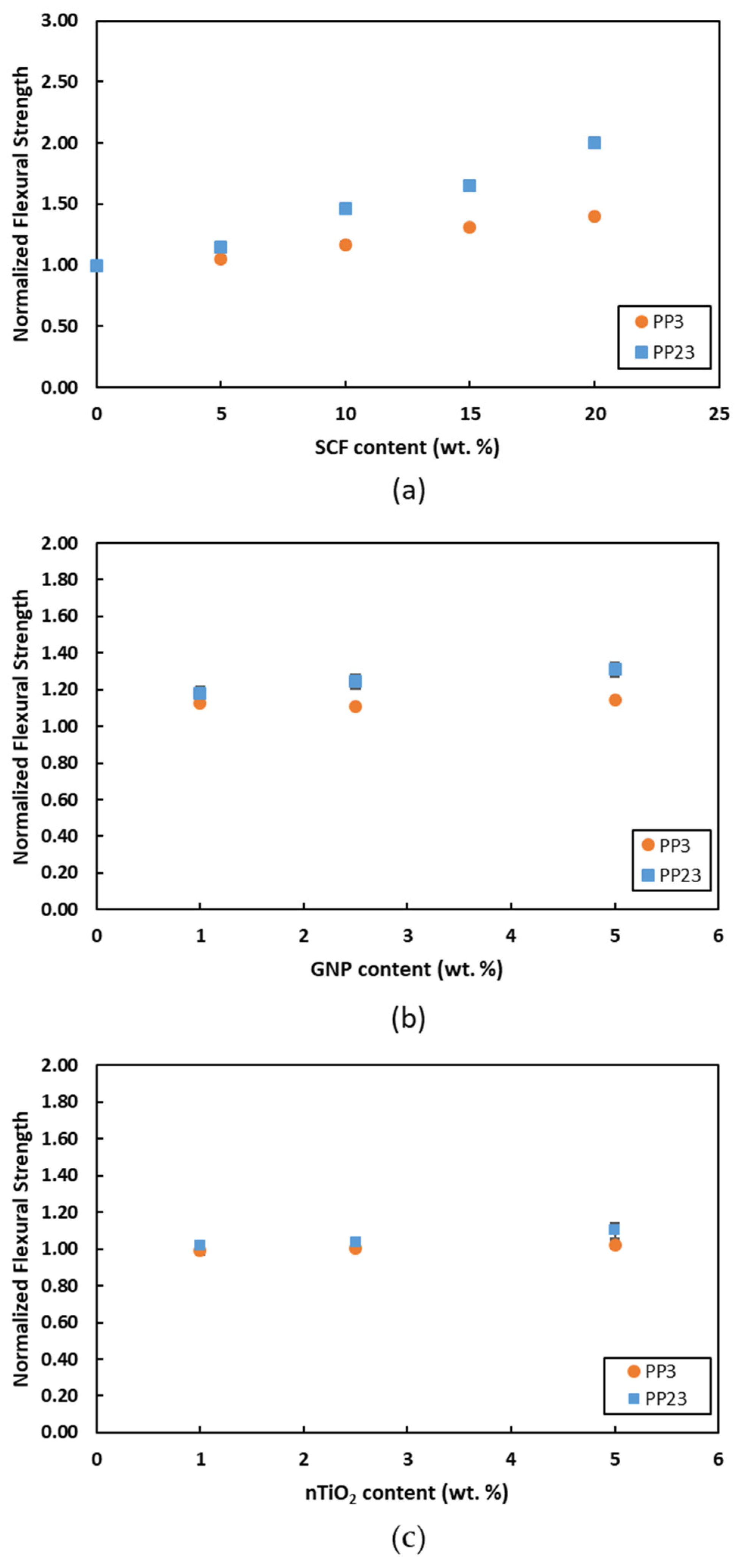

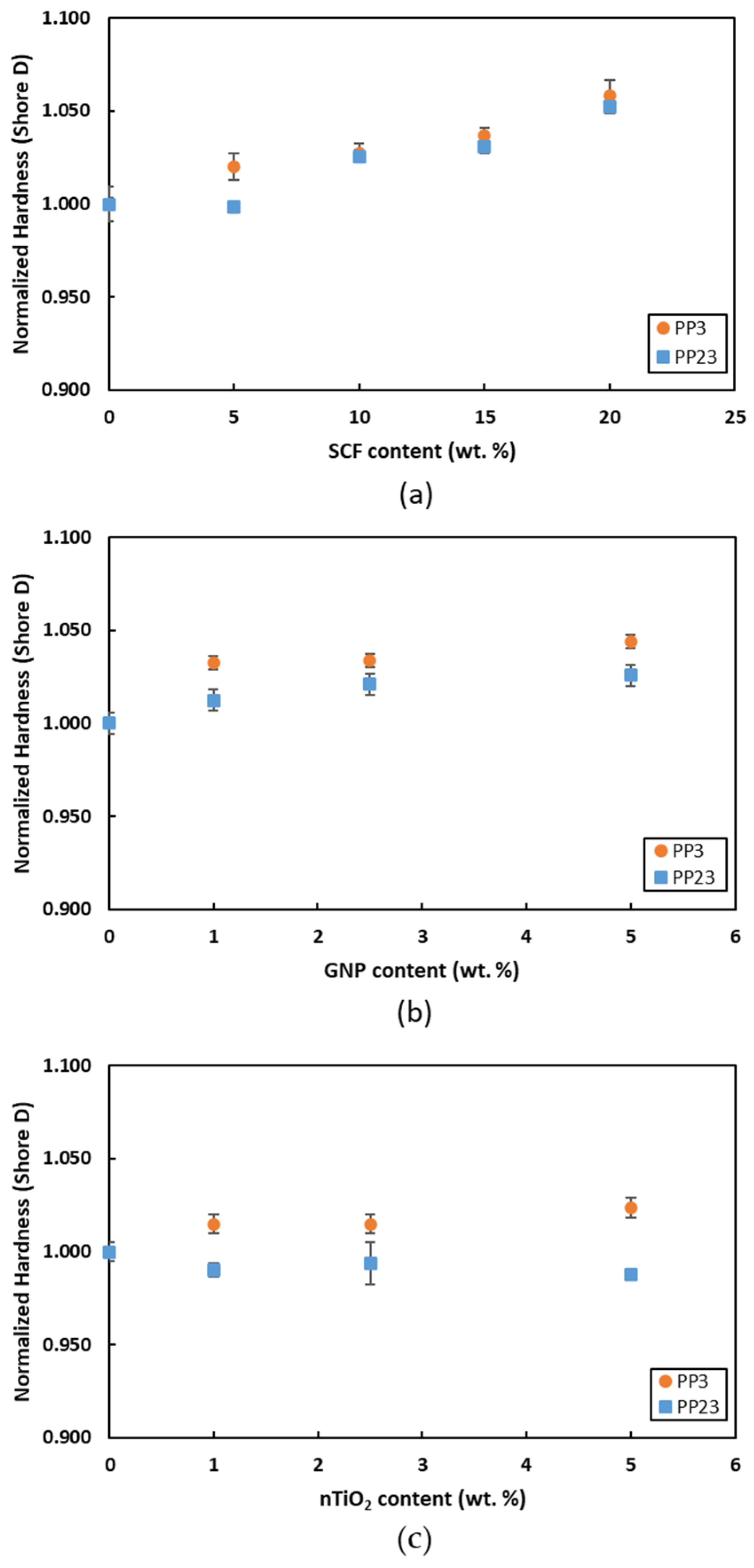
| Polypropylene Type | Name Tag | MFI (g/10 min) @2.16 kg and 230 °C | Density (g/cm3) |
|---|---|---|---|
| PP500 | PP3 | 3 | 0.900 |
| PP511A | PP23 | 23 | 0.900 |
| Name Tag | wt. % SCF | wt. % GNP | wt. % nTiO2 |
|---|---|---|---|
| Neat PP | - | - | - |
| PP/5SCF | 5 | - | - |
| PP/10SCF | 10 | - | - |
| PP/15SCF | 15 | - | - |
| PP/20SCF | 20 | - | - |
| PP/1GNP | - | 1 | - |
| PP/2.5GNP | - | 2.5 | - |
| PP/5GNP | - | 5 | - |
| PP/1nTiO2 | - | - | 1 |
| PP/2.5nTiO2 | - | - | 2.5 |
| PP/5nTiO2 | - | - | 5 |
| Type | Tensile Modulus (MPa) | UTS (MPa) | Strain at Break (%) | Stress at Fracture (MPa) |
|---|---|---|---|---|
| PP3 | 1643 ± 45 | 30 ± 0.6 | 553 ± 38.5 | 28.7 ± 0.3 |
| PP23 | 1358 ± 35 | 27.6 ± 0.3 | 845 ± 26.1 | 30.2 ± 0.7 |
Publisher’s Note: MDPI stays neutral with regard to jurisdictional claims in published maps and institutional affiliations. |
© 2022 by the authors. Licensee MDPI, Basel, Switzerland. This article is an open access article distributed under the terms and conditions of the Creative Commons Attribution (CC BY) license (https://creativecommons.org/licenses/by/4.0/).
Share and Cite
Junaedi, H.; Baig, M.; Dawood, A.; Albahkali, E.; Almajid, A. Effect of the Matrix Melt Flow Index and Fillers on Mechanical Properties of Polypropylene-Based Composites. Materials 2022, 15, 7568. https://doi.org/10.3390/ma15217568
Junaedi H, Baig M, Dawood A, Albahkali E, Almajid A. Effect of the Matrix Melt Flow Index and Fillers on Mechanical Properties of Polypropylene-Based Composites. Materials. 2022; 15(21):7568. https://doi.org/10.3390/ma15217568
Chicago/Turabian StyleJunaedi, Harri, Muneer Baig, Abdulsattar Dawood, Essam Albahkali, and Abdulhakim Almajid. 2022. "Effect of the Matrix Melt Flow Index and Fillers on Mechanical Properties of Polypropylene-Based Composites" Materials 15, no. 21: 7568. https://doi.org/10.3390/ma15217568
APA StyleJunaedi, H., Baig, M., Dawood, A., Albahkali, E., & Almajid, A. (2022). Effect of the Matrix Melt Flow Index and Fillers on Mechanical Properties of Polypropylene-Based Composites. Materials, 15(21), 7568. https://doi.org/10.3390/ma15217568






